Infrared astronomy is a sub-discipline of astronomy which specializes in the observation and analysis of astronomical objects using infrared (IR) radiation. The wavelength of infrared light ranges from 0.75 to 300 micrometers, and falls in between visible radiation, which ranges from 380 to 750 nanometers, and submillimeter waves.
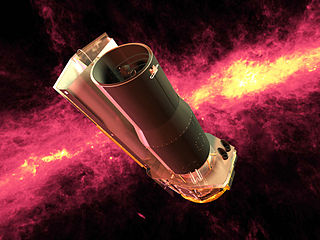
The Spitzer Space Telescope, formerly the Space Infrared Telescope Facility (SIRTF), was an infrared space telescope launched in 2003, that was deactivated when operations ended on 30 January 2020. Spitzer was the third space telescope dedicated to infrared astronomy, following IRAS (1983) and ISO (1995–1998). It was the first spacecraft to use an Earth-trailing orbit, later used by the Kepler planet-finder.

Observational cosmology is the study of the structure, the evolution and the origin of the universe through observation, using instruments such as telescopes and cosmic ray detectors.

The Stratospheric Observatory For Infrared Astronomy (SOFIA) was an 80/20 joint project of NASA and the German Aerospace Center (DLR) to construct and maintain an airborne observatory. NASA awarded the contract for the development of the aircraft, operation of the observatory and management of the American part of the project to the Universities Space Research Association (USRA) in 1996. The DSI managed the German parts of the project which were primarily science-and telescope-related. SOFIA's telescope saw first light on May 26, 2010. SOFIA was the successor to the Kuiper Airborne Observatory. During 10-hour, overnight flights, it observed celestial magnetic fields, star-forming regions, comets, nebulae, and the Galactic Center.
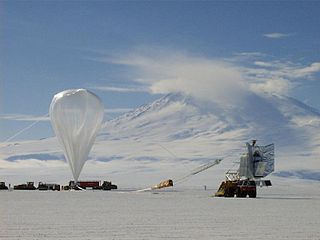
BOOMERanG experiment was an experiment that flew a telescope on a (high-altitude) balloon and measured the cosmic microwave background radiation of a part of the sky during three sub-orbital flights. It was the first experiment to make large, high-fidelity images of the CMB temperature anisotropies, and is best known for the discovery in 2000 that the geometry of the universe is close to flat, with similar results from the competing MAXIMA experiment.
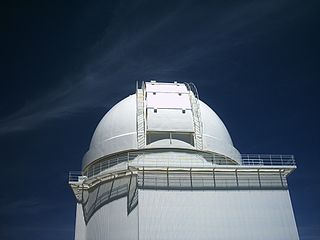
The Calar Alto Observatory is an astronomical observatory located in Almería province in Spain on Calar Alto, a 2,168-meter-high (7,113 ft) mountain in the Sierra de Los Filabres subrange of the Sierra Nevada.

Llano de Chajnantor Observatory is the name for a group of astronomical observatories located at an altitude of over 4,800 m (15,700 ft) in the Atacama Desert of northern Chile. The site is in the Antofagasta Region approximately 50 kilometres (31 mi) east of the town of San Pedro de Atacama. The exceptionally arid climate of the area is inhospitable to humans, but creates an excellent location for millimeter, submillimeter, and mid-infrared astronomy. This is because water vapour absorbs and attenuates submillimetre radiation. Llano de Chajnantor is home to the largest and most expensive astronomical telescope project in the world, the Atacama Large Millimeter Array (ALMA). Llano de Chajnantor and the surrounding area has been designated as the Chajnantor Science Reserve by the government of Chile.
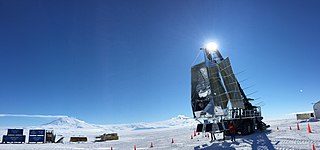
Spider is a balloon-borne experiment designed to search for primordial gravitational waves imprinted on the cosmic microwave background (CMB). Measuring the strength of this signal puts limits on inflationary theory.

Submillimeter Wave Astronomy Satellite is a NASA submillimetre astronomy satellite, and is the fourth spacecraft in the Small Explorer program (SMEX). It was launched on 6 December 1998, at 00:57:54 UTC, from Vandenberg Air Force Base aboard a Pegasus XL launch vehicle. The telescope was designed by the Smithsonian Astrophysical Observatory (SAO) and integrated by Ball Aerospace, while the spacecraft was built by NASA's Goddard Space Flight Center (GSFC). The mission's principal investigator is Gary J. Melnick.

Archeops was a balloon-borne instrument dedicated to measuring the Cosmic microwave background (CMB) temperature anisotropies. The study of this radiation is essential to obtain precise information on the evolution of the Universe: density, Hubble constant, age of the Universe, etc. To achieve this goal, measurements were done with devices cooled down at 100mK temperature placed at the focus of a warm telescope. To avoid atmospheric disturbance the whole apparatus is placed on a gondola below a helium balloon that reaches 40 km altitude.
The E and B Experiment (EBEX) was an experiment that measured the cosmic microwave background radiation of a part of the sky during two sub-orbital (high-altitude) balloon flights and took large, high-fidelity images of the CMB polarization anisotropies using a telescope which flew at over 42,000 metres (138,000 ft) high. The altitude of the telescope made it possible to reduce the atmospheric absorption of microwaves, which allowed massive cost reduction compared to a satellite probe, however, only a small part of the sky can be scanned and for a shorter duration than a typical satellite mission such as WMAP.

The kinetic inductance detector (KID) — also known as a microwave kinetic inductance detector (MKID) — is a type of superconducting photon detector capable of counting single photons whilst simultaneously measuring their energy and arrival time to high precision. They were first developed by scientists at the California Institute of Technology and the Jet Propulsion Laboratory in 2003. These devices operate at cryogenic temperatures, typically below 1 kelvin. They are being developed for high-sensitivity astronomical detection for frequencies ranging from the far-infrared to X-rays.
Calvin Barth Netterfield, known as Barth Netterfield, is a Canadian astrophysicist, and a Professor in the Department of Astronomy and the Department of Physics at the University of Toronto. He is a leading expert in the development of balloon-borne telescopes. These are astrophysical experiments that are lifted into the stratosphere by high-altitude balloons where they conduct observations that would be hindered by atmospheric interference if done on the ground. Netterfield is primarily known for his work in observational cosmology, specifically in developing instrumentation to observe the cosmic microwave background (CMB) radiation. Most notably, he was a key member of the instrument team for BOOMERANG, the experiment that made one of the first accurate determinations of the age, geometry, and mass-energy content of the universe. More recently, he has delved into the field of submillimetre astronomy and the physics of star formation, through his involvement with the BLAST telescope. Netterfield was featured prominently in BLAST!, a documentary film about the 2005 and 2006 flights of BLAST from Sweden and Antarctica.
The C-Band All Sky Survey (C-BASS) is a radio astronomy project that aims to map the entire sky in the C Band (5 GHz). It has been conducted on two radio telescopes, one operating in the Karoo in South Africa, the other at Owens Valley Radio Observatory in California.

The Super-pressure Balloon-borne Imaging Telescope (SuperBIT) is a highly stabilized, high-resolution telescope that operates in the stratosphere via NASA's superpressure balloon (SPB) system. At 40 km altitude above sea level, the football-stadium-sized balloon carries SuperBIT to a suborbital environment above 99.2% of the Earth's atmosphere in order to obtain space-quality imaging. As a research instrument, SuperBIT's primary science goal is to provide insight into the distribution of dark matter in galaxy clusters and throughout the large-scale structure of the universe. As demonstrated by numerous test flights, the survey data generated by SuperBIT is expected to have similar quality and data collection efficiency as the Hubble Space Telescope while complementing surveys from other up-and-coming observatories such as the James Webb Space Telescope (JWST), the Vera C. Rubin Observatory, and the Nancy Grace Roman Space Telescope.
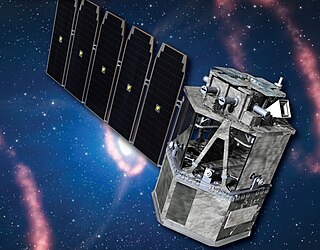
The Compton Spectrometer and Imager (COSI) is a NASA SMEX astrophysics mission that will launch a soft gamma-ray telescope in 2027. It is a wide-field compact Compton telescope (CCT) that is uniquely suited to investigate the "MeV gap". It provides imaging, spectroscopy, and polarimetry of astrophysical sources, and its germanium detectors provide excellent energy resolution for emission line measurements.

ASTHROS is a high-altitude balloon mission scheduled for launch in December 2024 from the Long Duration Balloon Facility near McMurdo Station in Antarctica. It will be located at an altitude of around 130,000 ft (40 km), and feature an 8.4 ft (2.6 m) telescope to collect far-infrared light, with the detectors cooled down to 4 K. Its main objective is to study stellar feedback in order to gain a better understanding of how star formation and galaxy evolution works. Originally scheduled for December 2023, it has since been pushed back to no earlier than December 2024. The weight of the observatory is estimated to be around 5,500 lb (2,500 kg).














